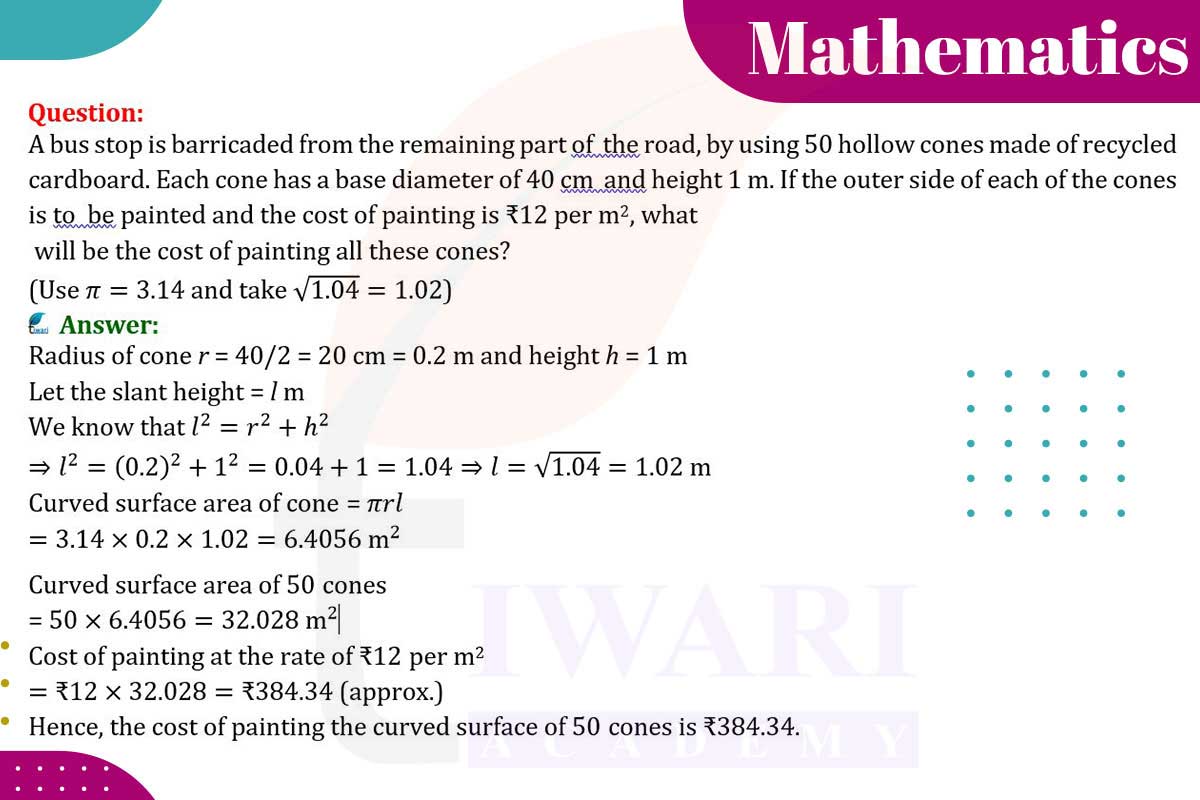To calculate the cost of painting 50 hollow cones used for barricading a bus stop, first determine the slant height and surface area of one cone. With a base diameter of 40 cm (radius 20 cm) and height 1 m (100 cm), the slant height (l) using Pythagoras’ theorem is l = √[h² + r²] = √[100² + 20²] = √[10000 + 400] = √[10400] = 102 cm. The surface area of one cone is 3.14 × 20 × 102 = 6424 cm² or 0.6424 m². For 50 cones, the area is 50 × 0.6424 = 32.12 m². At ₹12 per m², the total cost is 32.12 × 12 = ₹385.44.

Let’s discuss in detail
Introduction to the Project
The project involves painting 50 hollow cones made of recycled cardboard, which are used to barricade a bus stop. Each cone has specific dimensions: a base diameter of 40 cm and a height of 1 meter. The task is to calculate the total cost of painting the outer surface of these cones. The cost of painting is ₹12 per square meter. This scenario presents a practical application of geometric concepts in a real-world setting, combining the principles of surface area calculation with cost estimation.
Understanding Cone Geometry
A cone is a three-dimensional geometric shape with a circular base and a pointed top, known as the vertex. The height of the cone is the perpendicular distance from the base to the vertex. The slant height, which is crucial for calculating the curved surface area, is the length of the line segment from the vertex to any point on the circumference of the base. In this case, the cones are hollow, implying that only the outer surface needs to be painted.
Calculating the Slant Height
The slant height of each cone is determined using Pythagoras’ theorem. For a cone with a base radius of 20 cm (half of the diameter) and a height of 100 cm, the slant height (l) can be calculated as l = √[h² + r²]. Substituting the values, we get l = √[100² + 20²] = √[10000 + 400] = √[10400] = 102 cm.
Determining the Surface Area of One Cone
The surface area of one cone is calculated using the formula for the curved surface area of a cone, πrl. With the radius of 20 cm and the slant height of 102 cm, the surface area for one cone is 3.14 × 20 × 102 = 6424 cm², which is equivalent to 0.6424 m². This area represents the part of the cone that needs to be painted.
Calculating the Total Surface Area for Painting
To find the total area that needs to be painted for all 50 cones, we multiply the surface area of one cone by the total number of cones. Therefore, the total area to be painted is
50 × 0.6424 = 32.12 m². This calculation is essential for determining the amount of paint required and the associated cost.
Calculating the Total Cost of Painting
The final step is to calculate the total cost of painting all the cones. With the painting cost set at ₹12 per square meter, the total cost for painting 32.12 m² is 32.12 × 12 = ₹385.44. This cost estimation is crucial for budgeting and resource allocation in the project. It demonstrates how geometric calculations are directly applied in practical scenarios, such as urban planning and public works, where efficiency and cost-effectiveness are key considerations.
Discuss this question in detail or visit to Class 9 Maths Chapter 11 for all questions.
Questions of 9th Maths Exercise 11.1 in Detail

